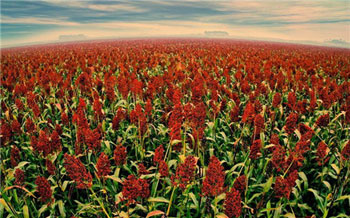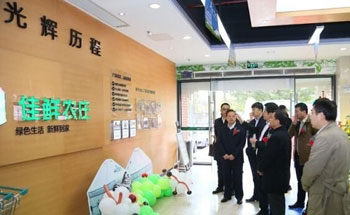Black soil planted red sorghum tannin high wine double fragrance
Original title: how to grow red sorghum on black soil?

Red sorghum for wine production is planted on black soil (file picture)
Some farmers in Nenjiang County, Heilongjiang Province tasted the benefits of growing sorghum last year. The yield per mu is 1000 to 1300 jin, the order price per jin is 0.8yuan, the market price is 0.90 yuan, and the income per hectare is more than 3000 yuan higher than that of corn. How is this done?
The secret of "tannin"
Jiao Shaojie, deputy director of the breeding Institute of the Heilongjiang Academy of Agricultural Sciences and a post scientist in the national sorghum industrial technology system, told reporters that farmers grow special-purpose sorghum for brewing, and the reason for selling is the high content of tannin.
"tannin is a kind of anthocyanin and an active substance, but it forms a complex in the process of animal digestion, which affects the absorption of protein. From a nutritional point of view, it is not a good thing." Jiao Shaojie said, "in the past, when sorghum was the staple grain, everyone had the experience that eating too much red sorghum was easy to get stomach trouble, which was caused by tannin."
However, tannins are a treasure in the brewing industry. Sorghum containing tannin produces classified compounds in the process of fermentation, forming a special aroma, which is the secret of the aroma of Chinese liquor. Domestic high-end liquor must have sorghum to participate in fermentation, domestic sorghum has also entered the wine-making vinegar industry.
Jiao Shaojie said: "the outstanding characteristics of Heilongjiang red sorghum are high starch content and moderate tannin content. The environmental characteristics of large temperature difference between day and night in the later growth stage of Heilongjiang sorghum are beneficial to the synthesis and accumulation of starch, and high starch lays the foundation for higher liquor rate. Sorghum grain also contains 1.5% tannin, which is fermented to form special aromatic compounds and polyphenols in the process of fermentation, which gives liquor unique aroma.
Sorghum is the only plant that contains tannin in cereal crops. Sorghum is mainly used in the feed industry in the international market. How to reduce tannin content and improve protein absorption has become an important standard for variety breeding, and low tannin content has become a foreign standard to measure the quality of sorghum. "the use of sorghum in China is mainly wine-making. Sorghum produced abroad has low tannin content and is not suitable for wine-making. The particularity of this use makes it difficult for foreign sorghum to enter the Chinese wine-making raw material market." Jiao Shaojie said.
In Nenjiang County, sorghum grown by Honggu Sorghum Professional Cooperative was packed into a special sorghum bag of Wuliangye Group and sent to Yibin, Sichuan Province. The person in charge of the cooperative said: "We took the sample to the factory, and the manufacturer identified that our variety is the most suitable brewing variety. First-class grain has planted more than 2000 mu of 'Longza 17' sorghum this year, and we will continue to expand the planting area next year."
Opportunities for Sorghum
Jiao Shaojie told reporters: "We have selected a new brewing sorghum variety 'Longza 17' which is suitable for mechanized planting." This is the most early-maturing hybrid sorghum variety registered and promoted in the country at present, which is suitable for mechanized cultivation and wine-making. This year, it has been popularized and planted in a large area in the first year of the province, covering an area of more than 200000 mu. The investment of planting sorghum is more than 2000 yuan less than that of corn per mu, and the purchase price is 0.20 yuan higher than that of corn. "
Nenjiang County Hong Grain seed Company, together with professional cooperatives, develops sorghum planting to provide seeds and cultivation guidance for cooperative farmers. in 2015, the county planted more than 50,000 mu of wine-making sorghum, with the highest yield of 10 tons per grain. They also signed orders with farmers to buy sorghum at a guaranteed rock-bottom price of 0.8 yuan per jin and sell it to wineries in the south via the Internet.
Tian Sheng Family Farm in Helen City has planted 60 kilos of sorghum this year, with a yield of more than 1200 jin per mu. Farmer Tian Sheng said: "I didn't expect a bumper harvest in the first year under the guidance of an expert. Roughly speaking, I earn more than 3000 yuan more than planting corn."
According to reports, Heilongjiang sorghum planting area has been concentrated in 45 °to 49 °north latitude for many years, located in the famous Songnen Plain. Due to the perennial wind and drought, low soil fertility and high salinity, sorghum has the characteristics of drought resistance, waterlogging resistance, saline-alkali tolerance and barren resistance to be brought into full play. Under the premise of comparative benefits, the medium-and low-yield fields can create higher yield and better economic benefits. Through the investigation of 400 soybean farmers in Nehe, Keshan, Helen and other major soybean producing counties, it is known that the number of farmers growing sorghum is increasing year by year. The main reason is that the comparative benefit of planting soybean is low and farmers have a strong desire for structural adjustment. In addition, the breeding and popularization of mechanized sorghum varieties and the mechanical equipment for planting soybean are suitable for planting sorghum, which also promote the expansion of sorghum planting area to soybean producing area.
The difficult problem of Sorghum
Industry insiders believe that the lack of necessary support puts sorghum at a disadvantage. Sorghum is a small miscellaneous grain crop, which does not have a leading impact on the local economy, and there is no clear task index in the assessment of governments at all levels. Therefore, in fact, there is little attention and policy support from the government. The agricultural subsidy policies implemented by the state, such as improved seed subsidies and direct subsidies for growing grain, do not include sorghum. Therefore, in the production of sorghum, farmers generally plant the main crops on the good land, which results in the instability of sorghum production due to the failure of planting, harvest and high yield.
The reporter learned that as sorghum is listed as a cash crop, in some reclamation areas, the price of land rent per hectare is more than 1000 yuan higher than that of food crops, and there is no subsidy.
Zou Jianqiu, chief scientist of the national sorghum industrial technology system, director of the National Sorghum improvement Center, and director of the Sorghum Research Institute of the Liaoning Academy of Agricultural Sciences, believes that Heilongjiang Province is a major grain-producing province in China, which has a great impact on the country's agricultural production and food security. At present, corn in this region is growing too fast and the planting structure is single, so there is an urgent need to adjust and optimize the planting structure, make full use of the existing land and climatic conditions, combine planting and cultivation, build a reasonable rotation system, and give full play to comparative advantages. to achieve stable grain income, quality improvement, efficiency and sustainable development.
At present, there is no corresponding supporting policy to promote the development of sorghum production in Heilongjiang Province. Zou Jianqiu suggested that the government should bring sorghum cultivation into the scope of agricultural subsidies, give special support to financial funds in the construction of raw material bases, and create a loose and preferential policy environment for sorghum deep processing enterprises in terms of funds, taxes, loans, land, and so on. we will vigorously support professional cooperative organizations for sorghum farmers, encourage cross-district operation of agricultural machinery in reclamation areas, and improve the level of agricultural mechanization, scale, standardization and science and technology of sorghum planting. (author: Liu Weilin)
- Prev

Xizang farmers rely on primitive means for winter irrigation
Xizang farmers rely on primitive means for winter irrigation
- Next

The whole industry chain of Guangdong agricultural reclamation makes up for the deficiency of e-commerce.
The whole industry chain of Guangdong agricultural reclamation makes up for the deficiency of e-commerce.
Related
- A course of planting techniques and methods on how to grow carrots
- How to plant the latest tulips?
- Is it better to pick tea in the morning or in the afternoon? When is the best time for tea to be picked? what is the third or fifth tea?
- Launch Yuanxiao Happy combination Haocha + Tea Yuan healthy Taste
- Penghu Tourism "Fireworks 20 Parade with You"
- 2022 West Lake Happiness holds "Digital Revitalization Voucher" and draws iphone13 and laptop.
- Banqiao Fuzhou social houses are designed to change start-up combined with police elimination to create a safe and livable environment
- The convenient measure of "mechanical weeding" in Xinbei has been abused and the Agriculture Bureau has imposed heavy penalties on the illegal land consolidation.
- Changgeng University Joins Hands with Four Memory Factories to Rescue Memory Talent Shortage
- The list of Taiwan's top 100 MVP managers is listed by the Director-General of the Farmers' Association of Sanxia District.

